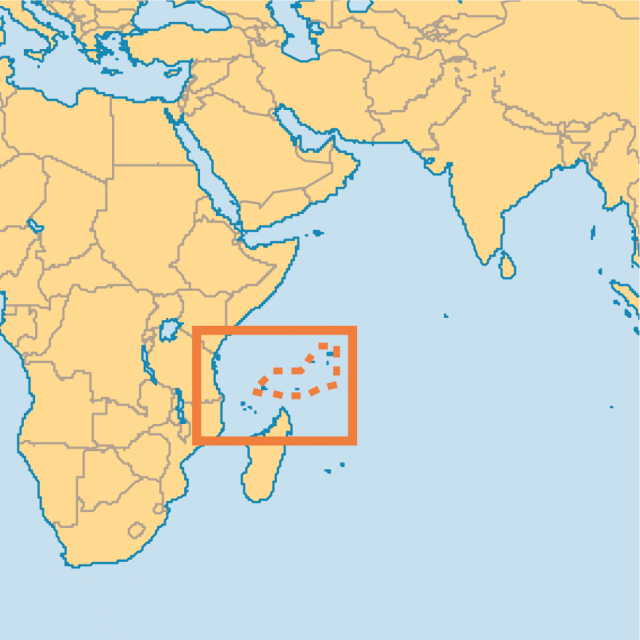Republic of Seychelles
POPULATION: 91,530 (2014)
AREA: 175 sq. mi. (454 sq. km)
LANGUAGES: English and French (both official); creole
NATIONAL CURRENCY: Seychelles rupee
PRINCIPAL RELIGIONS: Roman Catholic 90%, Anglican 8%, other 2%
CAPITAL CITY: Victoria, 25,000 (1993 est.); Main islands: Mahe, Praslin, La Digue
ANNUAL RAINFALL: On Mahe varies from 90 in. (2,300 mm) at sea level to 140 in. (3,560 mm) on mountain slopes.
ECONOMY: GDP $1.423 billion (2014)
PRINCIPAL PRODUCTS AND EXPORTS:
- Agricultural: vanilla, coconuts, sweet potatoes, cinnamon, cassava, bananas, poultry, fish (especially tuna)
- Manufacturing: fish processing and canning, coconut and vanilla processing, boat building, printing, furniture, beverages
- Services: Tourism
GOVERNMENT: Independence from Britain, 1976. Republic with president elected by universal suffrage. Governing bodies: 35-seat Asemblee Nationale and Cabinet of Ministers.
HEADS OF STATE SINCE INDEPENDENCE:
- 1976–1977 President James R. Mancham
- 1977– President France Albert Rene
ARMED FORCES: 200 (2001 est.)
EDUCATION: Compulsory for ages 6–15; literacy rate 84% (2001 est.)
The Seychelles is a nation consisting of about 115 islands in the Indian Ocean off Africa's east coast. A former British colony, it has been an independent republic since 1976. The country's inhabitants, the Seychellois, are descended from Europeans, Africans, and Asians who settled on the islands.
The heart of the Seychelles is a group of about 40 mountainous, rocky islands. The largest, Mahe, is home to about 80 percent of the country's population and contains Victoria, the nation's capital. Most of the rest of the Seychellois live on the nearby islands of Praslin and La Digue. The country also includes several outlying groups of flat, coral islands.

Arab seafarers may have visited the Seychelles before the 1500s. The first Europeans to explore the islands were the Portuguese, followed by the English and French. Despite these expeditions, the Seychelles remained uninhabited until 1770, when France established a small colony there. In the years that followed, France was at war with Britain and the colony surrendered to the British seven times. Finally in 1814 France formally turned the islands over to Britain. The Seychelles remained under British control, first as a territory of the colony of MAURITIUS and then as a separate colony, until it became independent.
In addition to the original French colonists, groups of people from southern India settled in the Seychelles. The French and Indians settlers brought large numbers of slaves to the islands, mostly from MADAGASCAR and the east African coast. By the early 1800s slaves accounted for more than 85 percent of the colony's population. In the early 1900s additional immigrants from India as well as some from China settled on the islands.
For many years the economy of the Seychelles depended on agriculture. Cotton, coconuts, vanilla, and cinnamon were important export crops. Since the 1970s TOURISM has developed into the islands' major economic activity. The international airport that opened on Mahe in 1971 has made travel to the Seychelles more convenient. Commercial tuna fishing and canning have also become important in recent
decades.
The Seychelles' first constitution established a multiparty democratic government. After a 1977 coup led by France Albert Rene, the nation adopted a one-party socialist system and Rene became president. In 1991, under pressure from Great Britain and France, the Seychelles restored the multiparty system. President Rene was reelected in 1993 and 1998. (See also Colonialism in Africa.)